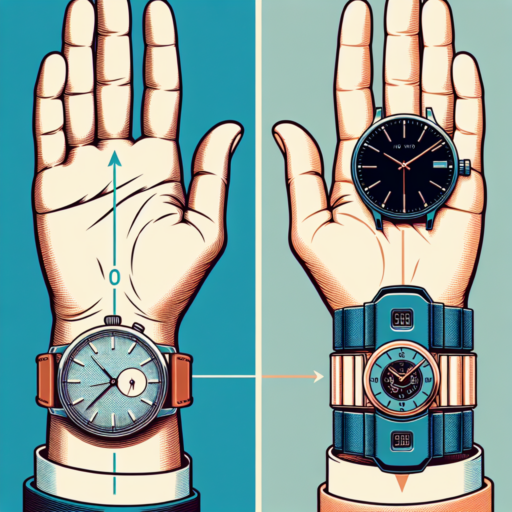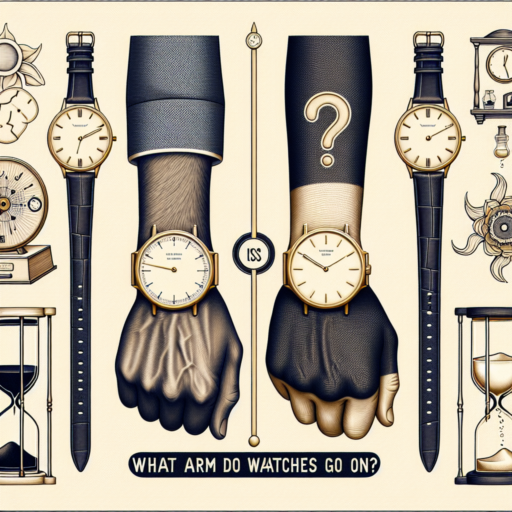Is it okay to wear a watch on the right hand?
Many people often wonder about the proper etiquette when it comes to wearing a watch. The question of whether it’s socially acceptable or even practical to wear a watch on the right hand is a topic of considerable discussion. Traditionally, watches have been worn on the left hand, primarily because the majority of the population is right-handed, and wearing a watch on the non-dominant hand makes it less susceptible to damage. However, the norms are shifting, and the choice of which wrist to adorn with a watch is becoming more flexible.
One of the main considerations in deciding to wear a watch on the right hand relates to comfort and personal preference. For left-handed individuals, wearing a watch on the right wrist is a practical choice that allows for ease of movement and access. Furthermore, the fashion and watch industries have acknowledged these preferences, with many designers creating watches that are aesthetically balanced for wear on either wrist. This inclusivity encourages personal expression and ensures that everyone can enjoy the functionality and style of a good watch, regardless of their dominant hand.
Another aspect to consider is the type of watch and its features. Some watches are designed with crowns and buttons that are more accessible when worn on the right wrist. This is particularly notable for divers’ watches and other specialized types, where ease of access to these controls can enhance the watch’s functionality during use. Therefore, the decision to wear a watch on the right hand can also be influenced by the specific design and intended use of the watch, highlighting the practical reasons beyond traditional etiquette.
Does my watch go on my left or right hand?
Deciding whether to wear your watch on the left or right hand is often a matter of personal preference, but there are traditional guidelines that can help make the choice clearer. Typically, watches are worn on the non-dominant hand. If you’re right-handed, this means your watch would likely feel more comfortable and less intrusive on your left wrist. Conversely, left-handed individuals might find wearing their watch on the right wrist to be more natural. This tradition stems from practicality; wearing your watch on the non-dominant hand makes it less likely to interfere with daily tasks and reduces the risk of damaging the watch.
Considerations for Wearing a Watch
- Comfort: The primary consideration for deciding which wrist to adorn with your watch should always be comfort. Regardless of tradition or recommendations, your comfort with the watch’s position is paramount.
- Functionality: Certain watches come with additional functionalities that might be easier to manipulate with your dominant hand. In such cases, wearing the watch on the opposite wrist ensures easier access and use.
- Social and Professional Norms: In some social and professional circles, there might be a preference or expectation for where a watch is worn. Observing these norms can be as important as personal comfort and convenience.
The question of whether to wear a watch on the left or right hand does not have a one-size-fits-all answer. While tradition suggests wearing it on your non-dominant hand for practical reasons, individual preferences and specific circumstances often dictate the most appropriate choice. Whether it’s for ease of use, comfort, or adherence to societal norms, the most important factor is that the watch serves its purpose for the wearer.
No se han encontrado productos.
Why do we wear watches on the left hand?
The practice of wearing watches on the left hand has become so ingrained in society that most people might not even question the reasons behind it. This custom can be traced back to multiple factors, ranging from practicality to tradition. Exploring these reasons can shed light on how this norm has shaped our watch-wearing habits over the years.
Historical and Practical Considerations
Historically, the majority of the population is right-handed, and this simple fact plays a significant role in the tradition of wearing watches on the left wrist. It is generally more convenient for right-handed individuals to wear a watch on the non-dominant hand, as it interferes less with day-to-day tasks. Additionally, wearing a watch on the left wrist can help in minimizing damage during manual activities, keeping the watch safer from knocks and dents that might occur during work or play.
Ease of Adjustments
Another practical reason for this custom relates to the ease of adjusting the watch. Traditionally, watches are designed with the crown on the right side, which makes them easier to adjust or wind with the right hand when worn on the left wrist. This arrangement ensures that adjustments can be made quickly and conveniently, without the need to remove the watch.
Tradition and Custom: Beyond practical and historical reasons, wearing watches on the left hand is also a matter of tradition. This custom has been passed down through generations, becoming a standard that is followed even by left-handed individuals in many cases. The enduring nature of this practice highlights how deeply rooted traditions can influence even simple aspects of our daily lives, such as how and where we wear our watches.
What are the characteristics of people who wear watches on their right hand?
Wearing a watch on the right hand is a choice that may reflect various personal and cultural characteristics. For many, it’s a matter of practicality and comfort, while for others, it can denote specific personal traits or professional requirements. Understanding these characteristics offers intriguing insights into the subtle ways individuals express their identity and preferences through such a simple action.
Preference for Non-Dominance
One common characteristic among people who wear watches on their right wrist is that they are often left-handed. Since the majority of the population is right-handed, watch designs traditionally cater to this group, positioning the crown on the right side of the watch face for easier adjustments with the right hand. Therefore, left-handed individuals find it more natural and convenient to wear their watch on the opposite wrist, allowing for easier manipulation with their dominant hand without the need to remove the watch.
Professional and Practical Considerations
Another distinctive trait pertains to professional and practical considerations. Individuals engaged in certain professions might choose to wear their watch on the right wrist to reduce wear and tear. For instance, those involved in manual labor, sports, or artistic fields might find wearing a watch on their non-dominant hand less intrusive and safer for both the watch and their activities. This choice underlines a practical approach to personal accessories, prioritizing function and durability over traditional customs.
Moreover, for some, the decision to wear a watch on the right hand is strategically chosen to make a statement or stand out. In a world where conforming to norms is common, selecting the less typical wrist for a watch can subtly showcase an individual’s willingness to diverge from the mainstream. This characteristic often reflects a broader mindset of valuing uniqueness and personal expression over adherence to societal expectations.




